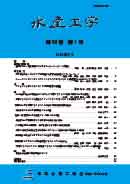Volume 59, Issue 1
Displaying 1-16 of 16 articles from this issue
- |<
- <
- 1
- >
- >|
Memorial Lecture Receiving the Award of the Society
-
2022Volume 59Issue 1 Pages 1-7
Published: June 15, 2022
Released on J-STAGE: June 10, 2022
Download PDF (6779K)
Research Articles
-
2022Volume 59Issue 1 Pages 9-17
Published: June 15, 2022
Released on J-STAGE: June 10, 2022
Download PDF (3831K) -
2022Volume 59Issue 1 Pages 19-26
Published: June 15, 2022
Released on J-STAGE: June 10, 2022
Download PDF (4898K)
Short Paper
-
2022Volume 59Issue 1 Pages 27-29
Published: June 15, 2022
Released on J-STAGE: June 10, 2022
Download PDF (1358K)
Reports
-
2022Volume 59Issue 1 Pages 31-36
Published: June 15, 2022
Released on J-STAGE: June 10, 2022
Download PDF (671K) -
2022Volume 59Issue 1 Pages 37-40
Published: June 15, 2022
Released on J-STAGE: June 10, 2022
Download PDF (2247K) -
2022Volume 59Issue 1 Pages 41-44
Published: June 15, 2022
Released on J-STAGE: June 10, 2022
Download PDF (1990K) -
2022Volume 59Issue 1 Pages 45-47
Published: June 15, 2022
Released on J-STAGE: June 10, 2022
Download PDF (3718K) -
2022Volume 59Issue 1 Pages 49-55
Published: June 15, 2022
Released on J-STAGE: June 10, 2022
Download PDF (1229K) -
2022Volume 59Issue 1 Pages 57-60
Published: June 15, 2022
Released on J-STAGE: June 10, 2022
Download PDF (6767K) -
2022Volume 59Issue 1 Pages 61-63
Published: June 15, 2022
Released on J-STAGE: June 10, 2022
Download PDF (3984K) -
2022Volume 59Issue 1 Pages 65-67
Published: June 15, 2022
Released on J-STAGE: June 10, 2022
Download PDF (574K) -
2022Volume 59Issue 1 Pages 69-71
Published: June 15, 2022
Released on J-STAGE: June 10, 2022
Download PDF (3412K) -
2022Volume 59Issue 1 Pages 73-79
Published: June 15, 2022
Released on J-STAGE: June 10, 2022
Download PDF (8258K) -
2022Volume 59Issue 1 Pages 81-83
Published: June 15, 2022
Released on J-STAGE: June 10, 2022
Download PDF (597K)
Technical Information
-
2022Volume 59Issue 1 Pages 85-86
Published: June 15, 2022
Released on J-STAGE: June 10, 2022
Download PDF (203K)
- |<
- <
- 1
- >
- >|
